Related sites:
Newsletter: Perspectives on Power Platform
Company: Niiranen Advisory Oy
Starting from July 19th, you no longer can/need to use a Windows Live ID to sign up for a 30 day trial of Microsoft Dynamics CRM Online. Instead you’re directed to the Microsoft Online Services Portal (a.k.a. MOP) to follow the same registration steps as you would when starting an Office 365 trial subscription. So, how does it work in practice then? Let’s sign up and see.
There are a few additional steps in the registration process now. In addition to specifying the name of your company, you also need to select a new domain name, such as “yourcompany.onmicrosoft.com”. You’re given the chance to check for domain name availability, but it’s important to note that this only checks the .onmicrosoft.com domain. Your actual CRM Online organization will still be at yourcompany.crm.dynamics.com (depending on the region) and if the name given already exists on that side, the CRM provisioning process will automatically adjust the URL (I sure hope it’s better than those org85fs321nad type of CRM organization name monsters we had before). Additionally, since we don’t yet have a Microsoft Online user account in this case (if we did, the process would be somewhat easier), we’ll need to provide a user name and password.
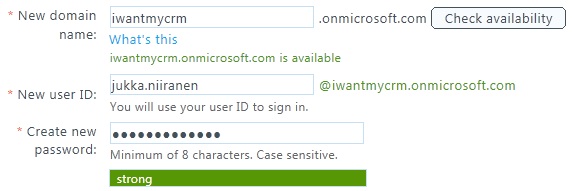
Once the data input has been accepted, we’re greeted with the administration portal that’s familiar to anyone who’s been managing an Office 365 subscription. Instead of the Exchange, Lync and SharePoint services we’ll see Dynamics CRM as the only available option. The actual provisioning process can take a while, so you may need to keep your eye on the spinner and refresh the screen quite a few times. In the US data centers the process took just a couple of minutes, but in EMEA I had to wait for half an hour before CRM was enabled in the Microsoft Online trial subscription. Presumably things will speed up as CRM becomes an everyday part of the Online portal.
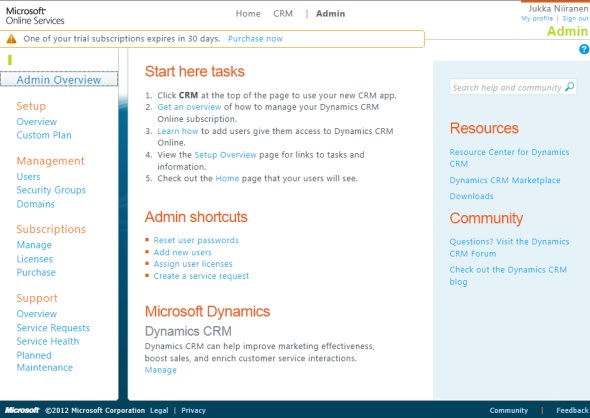
Under Dynamics CRM there’s a Manage link, so let’s click on that and off we go… Ouch, grey screen! You weren’t using a non-IE browser, now were you? Just because Office 365 web apps are compatible with most browsers, doesn’t mean Dynamics CRM would be. Remember how that cross-browser support was re-scheduled to Q4 2012? That’s ok, it’s easy to forget such minor details. Also, since Microsoft still doesn’t want to make it clear to the potential customer what the system requirements for Dynamics CRM are, many of them will surely be greeted with the below screen once they login to their CRM Online trial with Chrome, Firefox or Safari, puzzled about why they’re seeing this mobile UI instead of the pretty charts and familiar Office experience they were promised.

After we click on the CRM link inside MOP with Internet Explorer, we get an additional dialog that used to be a part of the CRM Online sign-up form: selecting the base currency for the CRM organization. Once done, the familiar CRM provisioning screen is presented, alongside the promotional WMV video telling us how Dynamics CRM will improve your productivity etc. Wait a couple of minutes and you’re given the button to launch CRM Online.
From this point onward the user experience is exactly the way it used to be back in the Windows Live ID days. Once you go to add more users into your CRM Online subscription there is however something new in the UI: instead of allowing you to add new CRM user records, a popup window will instruct you that in order to add more users to Microsoft Dynamics CRM Online, you’ll need to go to the Microsoft Office 365 Admin Portal.
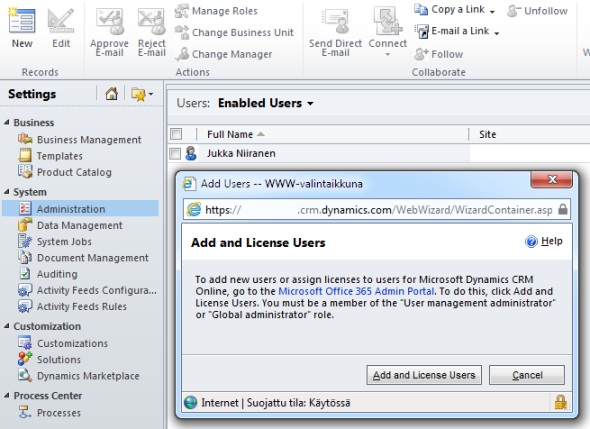
Ok, let’s click on the Add and Licenses Users button. We’re taken to the Online Services portal and get to specify a name for the new user. There’s also a “bulk add” option available, but since that would require creating and uploading a CSV file, we’ll skip that for now. Similarly to the subscription administrator (the first CRM user you created), the new users will be given a [email protected] user name. You can enter more details for the user, but not an email address (more on that later).
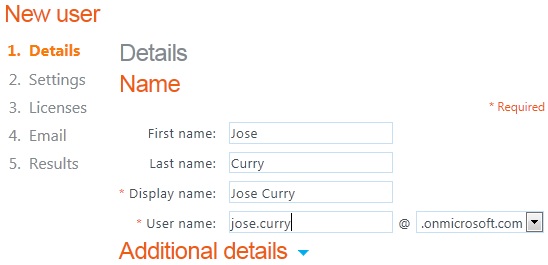
Moving forward, we’re given the option to grant a CRM user license to the user. However, unlike the native CRM dialog windows for adding users, the MOP dialogs won’t allow you to assign any CRM security roles to the new users. Instead, you’ll need to go back to the Dynamics CRM administration menus to perform this operation. Don’t forget this part, as otherwise your users will have a user account but no access rights to CRM.

Ok, we’re now almost done and are presented with the option of sending details of the new user name and temporary password by email. By default the recipient will be the admin user. Don’t send it there. Why? Because even though it looks like an email address and MOP considers it to be one, there is no email service available for you to access this inbox. Remember: you’re just configuring a CRM Online trial, not Exchange Online. So put a real email address in there, or then just copy & paste the data from the next screen.
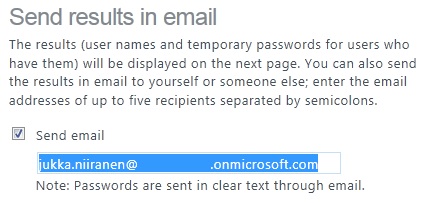
Once the new user account becomes available in the CRM users view (it can take a couple of minutes), you can open up the record and assign the required security roles to the user. Another thing you should do is to specify the real email address of the new user, so replace the @onmicrosoft address with a proper business email. While you’re at it, you may notice that not all user profile fields are available for editing on the CRM user form like they would normally be. Changing details like job title, main phone, mobile phone etc. needs to be done in the Microsoft Online Services portal and not CRM, as these are part of the user information maintained in MOP’s directory. Unlike in a traditional on-premises implementation with Active Directory, changes to the user profile fields will actually be updated onto the corresponding CRM user record after it has been created. See the following MSDN article for details: Sychronized Users in Microsoft Dynamics CRM Online and Office 365.
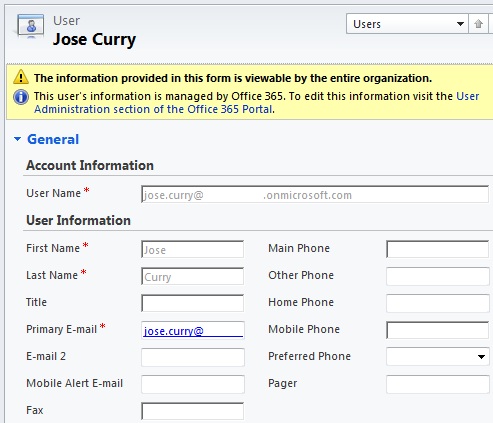
In addition to user management, also the subscription management for CRM Online now utilizes the Office 365 platform capabilities rather than the old system that was used for billing Xbox Live credits and other consumer services. What this means is that a potential customer might as well go and sign up for an Office 365 trial to go alongside their CRM Online trial. All it takes is finding the link under Subscriptions – Purchase – Microsoft Office 365 (Plan E3) – Trial and they can take the Exchange, SharePoint and Lync functionality for a test drive. Cross-sell opportunities galore!
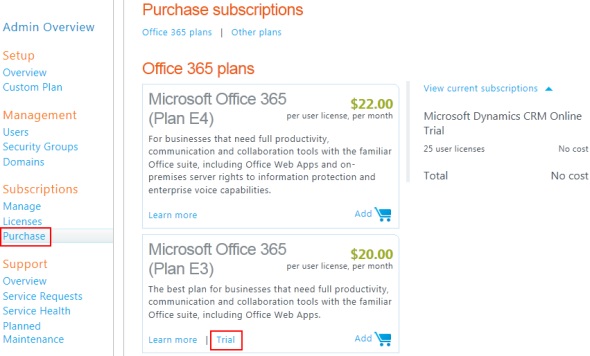
Are there any benefits then for a customer who just wants CRM from the public cloud and not Office 365? Yes, because the new Microsoft Online based authentication allows setting up an integration with the existing Active Directory that the customer has. No need to manage separate credentials for CRM Online anymore if you configure AD federation between your domain and the cloud services hosted in Microsoft’s data centers to offer the users a single sign-on (SSO) experience. It requires some level of effort, though, so start by getting to know the following article: Plan for and deploy AD FS 2.0 for use with single sign-on.
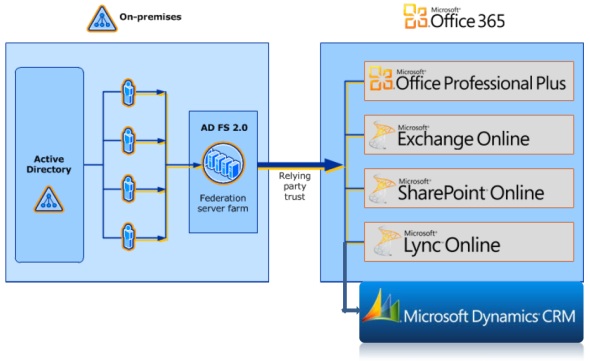
Another nice addition is the access to a CRM Online Service Health dashboard. Similar to what Office 365 has offered, you can now also see information about the current status and pas issues related to various CRM Online service components. While Microsoft has actively promoted the new CRM Online Trust Center, effectively it’s just a static page with information regarding security policies and certifications. In comparison, the Office 365 (and now CRM Online) Service Health dashboard will tell you what’s going on with the service right now and what maintenance breaks are planned. Compared to, say, trust.salesforce.com, it’s less transparent due to the requirement of having an administrator login to access the information, but it’s a good start.
What if you’ve already implemented CRM Online and want to take advantage of the integration with Office 365 user accounts or on-premises AD? At the moment, there’s not much you can do. The changes introduced on July 19th only apply to new CRM Online organizations, which will now be provisioned onto the Online Services Delivery Platform (OSDP). Existing organizations on the old Commerce Transaction Platform (CTP) will eventually be migrated, but there is no official schedule for this yet.
My guess would be that we’re not going to see any updates for existing CRM Online customers until the Office 2013 wave of updates rolls out to Office 365 customers, as Microsoft will surely put all its resources behind ensuring the Windows 8 launch with the accompanying business apps is a success. With plenty of other things on the Dynamics CRM development roadmap, it may take another year before we can finally say goodbye to the Windows Live ID based authentication in CRM Online. In the meantime, why not sign up for an Office 365 Enterprise Preview to see what the 2013 wave has to offer on SharePoint, Office and other products?
Edit 2012-07-31: here’s a list of a few Office 365 issues that can cause problems for new CRM Online organizations:
This can’t be good if existing customers have to wait a year for functionality new customers get today. I wonder if the Service Health dashboard will become available sooner. This is where you see the limitations of multi-tenant hosting of on-premise software over a true cloud platform (Hotmail, Skydrive). I think eventually Microsoft will have to build Office 365 & CRM online as an elastic cloud platform. This is the only way to deliver consistent customer experience at lower costs.
If you compare the situation to Office 365 that was released one year ago, then it took several months for most BPOS customers to be scheduled for migration. CRM Online was made available on OSDP already in December 2011, but only to a limited set of customers and now 7 months later to new customer sign-ups. If by December 2012 we would have also existing CRM Online customers transitioned, I’d be positively surprised. Since the Service Health dashboard is an Office 365 feature, I think there’s almost zero chance that it would be replicated on the old platform anymore.
I agree with point about true cloud apps being more agile than multi-tenant server software, but I’m not 100% if that’s what all the customers would really prefer. Single user software like Hotmail has considerably less dependencies than business information systems where thousands of users and tens of integrated systems may need to follow a well defined, common process from day to day in order to deliver the business result expected. When you change the UI of a webmail app, it’s just the UX of the single user that temporarily takes a hit, whereas performing a silent upgrade like CRM 4.0 -> CRM 2011 overnight without letting the customer know about it would wreak havoc on a different scale.
I don’t think it’s necessarily a bad thing that not all tenants are forced to upgrade at the same moment when it comes to business applications in the cloud. What I do think is bad that there’s rarely enough information publicly available about the planned schedules for upcoming changes to MS products. It’s a bit like how Nokia used to launch their products: “Here’s our brand new flagship phone! When can you buy it from the stores? Umm, we don’t know, check back in 6 months, m’kay?” …compared to Apple’s approach of “The New iPhone. Available in stores next week”. Same end result (new product in the hands of the customer) with completely different customer experiences.
As it so just happens, Microsoft actually migrated Hotmail users to the new Outlook.com experience today! http://www.neowin.net/news/everything-you-need-to-know-about-outlookcom-is-right-here?a
So, which is better: a service that changes radically overnight or one that the customers and partners have time to prepare for during updates? Both surely have their ups and downs.
Well i have taken up the CRM2011 trial so i can have a bit of a play at home and thought i would also like to take trial of a plan with the sharepoint online included. This is so that i could test out how the CRM-sharepoint integration works.
Everytime i try i keep getting an error message so it seems that under the same account you cannot get another package trial simultaneously which frankly is bloody annoying. It seems the only work around is to create a separate account so that you can take a trial under a different admin account. I am sure this is going to have all sorts of issues for setting up security and additional users though. Not sure i have the energy for that one tonight. Perhaps Jukka you could investigate and blog so i dont have to think about that one 😉
What kind of an error are you getting and in which phase of the process, Daniel? I signed up for a CRM trial on MOP yesterday and today I added an Office 365 trial into the same account – no errors. The process did require me to sign out of my Microsoft Online Services account and back in before I was able to see Exchange, SharePoint etc. listed as services in the admin portal, but other than that I didn’t encounter any problems. I was able to also add the List Component into the SharePoint Online site without any issues.
Note: I did this on a US data center account. The reason I had created that trial in the first place was because the CRM provisioning was taking forever when using an EMEA based account, so there might be some hick-ups in the European version of the service.
Hi Jukka – thanks very much for a most informative article.
Do you know whether this new way of provisioning CRM Online enables a partner to administer CRM Online for their customer **without** consuming a CRM licence (for each and every customer)? Also do you know how you go about this **on behalf of** a customer?
With LiveID there were a couple of different ways to do this but because MS insisted on verifying one’s identity by sending an email to the primary email address associated with the LiveID used neither was ideal. Either the customer had to be involved (setting up a LiveID, trusting the partner with the password and clicking on confirmation emails) or the partner set it up with their LiveID and then had to follow a complicated process (from memory) to delegate administration and billing to LiveID(s) associated with the customer. Users (and probably partner users) with (or in their various attempts, gaining) several LiveIDs could be really problematic. Any thoughts on whether this has got better now?
Although I’ve been reading some of the presentation materials available at PartnerSource, I haven’t yet really figured out if there are some improvements to the whole administration process from a Microsoft partner perspective. Since the platform is now the same as with Office 365, the features available on it like trial invitations / purchase offers will become available automatically. However, the Delegated Administration feature appears to be fairly useless from a CRM perspective if all that it allows is access to the MOP admin page. Sure, if you’re setting up domains or AD federation then that might be sufficient, but anything that has to do with actual CRM application functionality is beyond the portal. Moreover, if you can’t event assign CRM security roles from the portal, then even if you would get the admin delegation for a customer environment, it still needs someone at the customer’s end to assign a user the System Administrator role in Dynamics CRM.
I’m not quite sure how the delegated administration works on the partner organization’s end. Can any user associated with the partner access the customer’s MOP admin portal? Hopefully not, but then again, since CRM will require specific user accounts to be available in the systemuser table to be able to log in, I guess there’s no way to grant company level access rights to CRM even in theory. Also, most likely the customer will have to pay the ~$528 annual fee for each partner user account that exists in their CRM system.
I think some cloud platforms managed to phase in upgrades . Facebook with Timeline and Google with Gmail/Docs told users here’s a new feature, you can switch now (and even revert to the old version in Google’s case) but sometimes in the near future, we will switch anyway. This may be easier to do with web applications than with business applications.
Thanks Jukka – It’s getting a little clearer but still plenty to figure out… I guess that if we were now able to give a delegated administrator the “restricted” licence (i.e. like on-premise) this might do what we all want?
From a quick search on office 365 delegated administration it looks like this may only be available for **Enterprise** O365 plans – a shame because its the small business/professional clients that most need it and for whom an extra licence is the most significant incremental cost…
As for partner organisation vs partner users it looks like (a quick search again) that the partner organisation requests it, the client grants it (to the partner organisation) but the partner’s administrator decides which of it’s users get to be delegated administrators for their clients (seemingly for all of them).
All of this seems to be inside the Office 365 plan and not the Microsoft Online Services Portal itself – I’m still pretty confused…
Unfortunately it looks like there are no other license options available in the new cloud than the full paid license (see updated post). So, even though the customer might be able to grant delegated administrator rights to a partner organization and the partner could then internally manage which of its users have admin access to their customers’ environments with their personal MOP ID’s, the customer would probably need to grant a paid CRM license to each individual person in the partner organization who needs to access CRM. Which would mean that the whole effort would be pointless really, since creating a single admin account per customer organization is economically much more sensible. Again, I haven’t yet had a chance to try the process in practice, so I’ll update my experiences here once I admin rights to our partner MOP site.
As what comes to the Office 365 Plan P, I think the limitations on that one are so significant that almost everyone is recommending customers to forget about P1 and go straight for the E plans. For example, there is no support for Microsoft Dynamics CRM 2011 List Component for SharePoint in the P plan. What makes it even worse is that you can’t upgrade from a Plan P to Plan E, so everyone should in practice go straight to the “Enterprise” versions if they are considering Office 365 for email, IM and document management.
Great article! I did want to mention something in regard to the connection issues using plugin registration/ dev toolkit tool with the CRM instance. The solution provided in the forum thread you have referenced does not solve the dev toolkit connection issue. Here is a little more detail about the error and such:
http://gotcrm.blogspot.com/2012/08/username-cannot-be-null-error-message.html
[…] CRM Online -käyttäjille avata koekäyttöympäristö hyödyntäen Office 365 -alustalta tuttuja Microsoft Online Services -tunnuksia. Aiemmin vain nykyisten Office 365 -tilaajien saatavilla ollut kanava Dynamics CRM Onlinen […]
We now have confirmation from Microsoft that the Delegated Administration feature cannot be used for granting the partner organization access to the Dynamics CRM Online application. The customer will need to purchase and assign a license for the MS Partner organization unless they want to go totally DIY and deploy customization packages themselves, handle application configuration tasks etc.
[…] can read more about how the new Office 365 integration affects the CRM Online provisioning process here.) You can bring in your own system’s customizations by exporting the solution files and […]
Hi Jukka, excellent article!
I’m a newcomer in crm online authentication issues.
Do you know if the crm online trial version has enabled the web services?
Because I have this strange situation with the example PHP2CRMOnline from the CRM2011Kit:
If I use the crm account “[email protected]” I got the error “The entered and stored passwords do not match.” in the first step of authentication.
So just for try, I used my user account for hotmail, and pass the authentication step successfully, but fails when it tries to create the account in the CRM (createAccount function).
I got the error message: “An error occurred when verifying security for the message”.
I don’t understant why the crm account is not working and the hotmail account works fine in the authentication step.
Thank you for you time, from a rainy Argentina.
Gustavo
Thanks for the feedback, Gustavo. I don’t work with the SDK myself, but I would imagine that the Dynamics CRM 2011 Developer Training Kit (if that’s what you’re referring to with CRM2011Kit) simply hasn’t been updated to be compatible with the new authentication method for CRM Online instances running on Office 365’s OSDP. Actually I’m not sure if it’s called OSDP (Online Services Delivert Platform) or OCP (Online Commerce Platform), since this post from Girish Raja on September 4th seems to now use the latter term: Authentication with Dynamics CRM Online on OCP (Office 365). The post contains some links that might be helpful in identifying where the problem is, or then you could post a question to Girish directly.
In general, I think it’s pretty safe to assume that many of the CRM tools or code samples published before Q3 2012 won’t work right out of the box with the OSDP/OCP authentication. Even though the new platform has technically been available for over half a year now, since it was initially limited to only existing Office 365 subscribers purchasing CRM Online through their MOP account and not the new CRM trial organizations that 99% of people most likely used, no one had much of an incentive to update their code to support the additional CRM Online authentication method.
Thanks a lot for your quick reply!
It seems that to work with Microsoft products you have to use microsoft languages c# o vb.. for php developers is more difficult..
Best regards,
Gustavo.
[…] that new CRM Online organizations are created by signing in with Microsoft Online Services accounts instead of WLID, it’s good to note that a MOP account on Office 365 is not the same as a […]
[…] Microsoft CRM organizations created prior – they continue to be on LiveID. See this write-up on the benefits that Microsoft Office 365 authentication […]
[…] Microsoft CRM organizations created prior – they continue to be on LiveID. See this write-up on the benefits that Microsoft Office 365 authentication […]